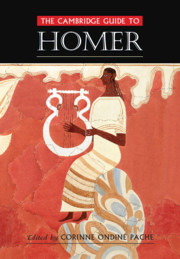Book contents
- The Cambridge Guide to Homer
- The Cambridge Guide to Homer
- Copyright page
- Contents
- Figures
- Notes on the Contributors
- General Introduction
- Part I Homeric Song and Text
- Introduction
- Homeric Epic in Performance
- Homeric Poetics
- Homer in a World of Song
- Epic Traditions
- Mythic Background
- The Language of Homer
- From Song to Text
- Key Topics
- Part II Homeric World
- Part III Homer in the World
- Bibliography
- Index
- References
Homeric Poetics
from Part I - Homeric Song and Text
Published online by Cambridge University Press: 22 February 2020
- The Cambridge Guide to Homer
- The Cambridge Guide to Homer
- Copyright page
- Contents
- Figures
- Notes on the Contributors
- General Introduction
- Part I Homeric Song and Text
- Introduction
- Homeric Epic in Performance
- Homeric Poetics
- Homer in a World of Song
- Epic Traditions
- Mythic Background
- The Language of Homer
- From Song to Text
- Key Topics
- Part II Homeric World
- Part III Homer in the World
- Bibliography
- Index
- References
Summary
Starting from the demonstration by Milman Parry and Albert Lord that a complex traditional system developed over centuries for the composition in performance of epic song by deeply experienced poets is the engine of Homeric poetry, this essay describes the way that meaning is generated and can be identified within such a system. In all of the elements of the poem, from the smallest compositional unit (the line and its components) to the largest (the overall song consisting of many scroll-length songs each of which consists of concatenated themes), the experienced interpreter must grasp both its horizontal and vertical aspects ‒ in other words, an element’s place within the hierarchy of the whole as well as what differentiates any given element from its likes elsewhere in the tradition.
- Type
- Chapter
- Information
- The Cambridge Guide to Homer , pp. 21 - 35Publisher: Cambridge University PressPrint publication year: 2020

